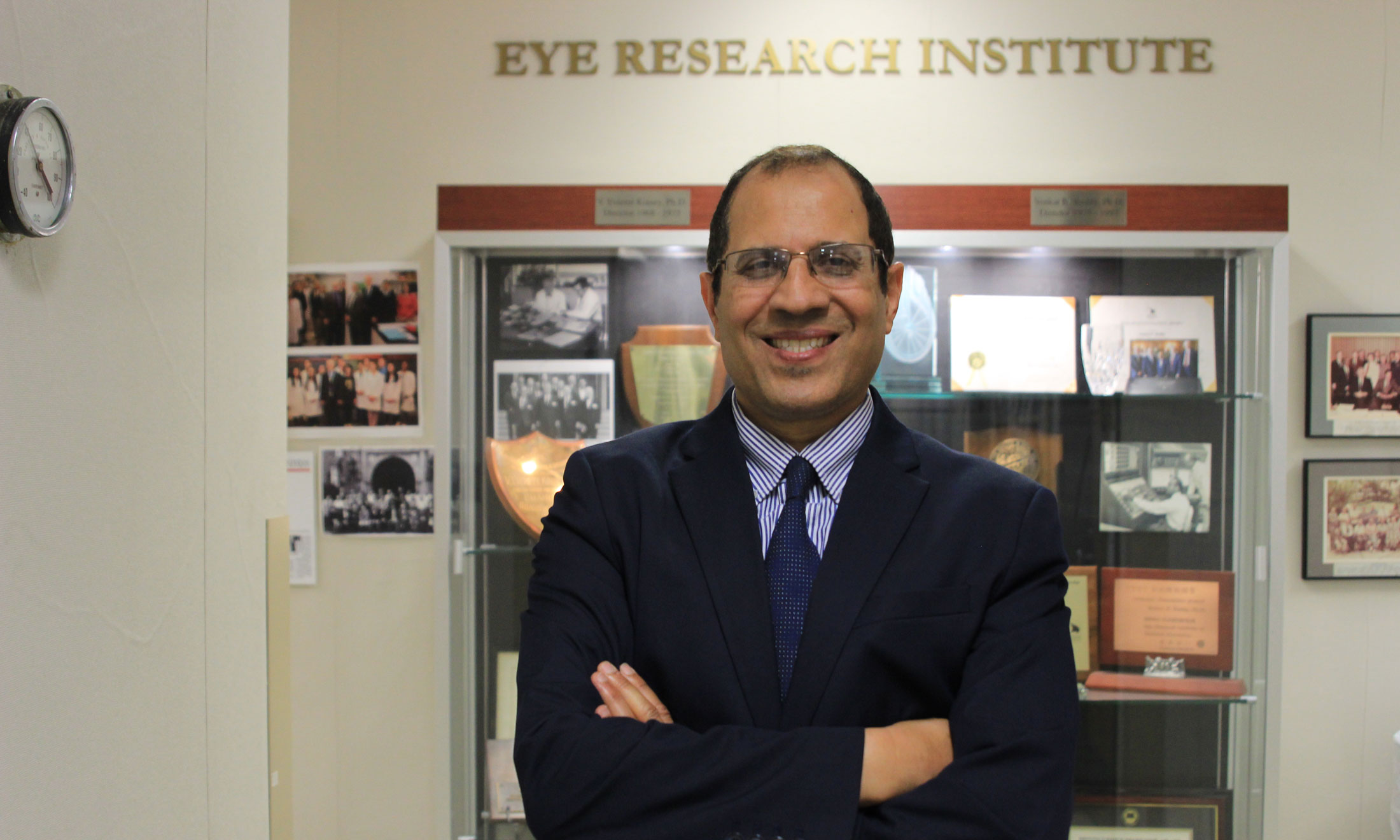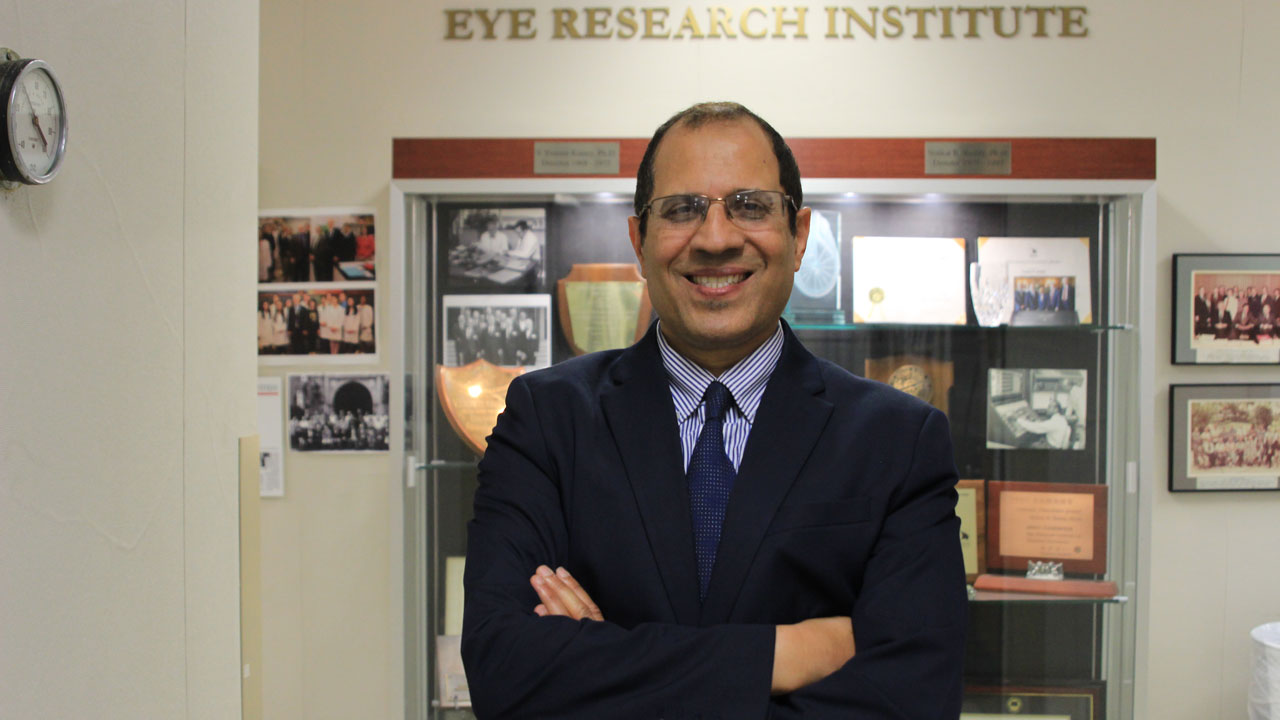OU welcomes new director of Eye Research Institute, founding director of OUWB Eye Research Center

Dr. Mohamed Al-Shabrawey is the new director of OU's Eye Research Institute and founding director of the Eye Research Center at Oakland University William Beaumont School of Medicine.

Oakland University has welcomed Mohamed Al-Shabrawey as the new director of OU’s Eye Research Institute (ERI) and founding director of the Eye Research Center (ERC) at Oakland University William Beaumont School of Medicine (OUWB).
Dr. Al-Shabrawey is an expert on the study of diabetic retinopathy, a major cause of blindness worldwide, and has published nearly 70 refereed articles on the disease in the past 20 years. His research funding has included major grants from the National Eye Institute and the American Heart Association, and he currently possesses a NIH R01 grant that extends to 2024.
Along with his director role, Dr. Al-Shabrawey is the first V. Everett Kinsey Endowed Professor of Biomedical Sciences in the ERI. Dr. Kinsey was a co-founder of the ERI in 1968 and the recipient of a prestigious Lasker Award in 1956 for his pioneering studies on the pediatric eye disease of retinopathy in children born prematurely.
Dr. Al-Shabrawey comes to OU from the Culver Vision Discovery Institute of Augusta University in Augusta, Georgia. He succeeds Frank Giblin, distinguished professor emeritus of biomedical sciences, who had served as ERI director since 2004 and recently retired after 47 years at Oakland.
"Dr. Al-Shabrawey's leadership will further elevate ERI as a preeminent international resource for eye research, and his vision aligns with the legacy established by Dr. Kinsey and developed by Professor Giblin," said OU President Dr. Ora Hirsch Pescovitz. "Working closely with researchers from around the university, the institute's multidisciplinary approach creates a dynamic research enterprise that ensures Oakland University has a major impact on diagnosing, treating, and preventing eye diseases."
“We are thrilled that Dr. Al-Shabrawey has joined Oakland University to lead the ERI and the ERC,” added OU Provost and Executive Vice President for Academic Affairs Dr. Britt Rios-Ellis. “The breadth of his experience and knowledge will further strengthen the legacy of transformative contributions to eye research. We are also very excited to welcome his life partner Dr. Tawfik and her exciting work on macular degeneration. They are truly a renowned dynamic duo focused on eye research.”
Dr. Al-Shabrawey’s wife, Amany Tawfik, has joined Oakland University as an associate professor in the Eye Research Institute. Formerly an emergency medicine physician, Dr. Tawfik holds a NIH RO1 grant that supports her research on age-related macular degeneration. Before coming to OU, she worked with Dr. Al-Shabrawey at the Culver Vision Discovery Institute at Augusta University.
Within OUWB, Dr. Al-Shabrawey will serve as founding director of the OUWB Eye Research Center (ERC) and professor of Foundational Medical Studies. Researchers at the ERC will collaborate with researchers in OUWB, across other areas of the university, and with clinician researchers in the Ophthalmology department at Beaumont Hospital to translate basic science research into tools and therapies that can help diagnose, treat and prevent of eye-related diseases. The ERI will operate as a component of the ERC, but will retain its independent status as a unit within the university.
“Oakland University has all the necessary stakeholders to execute an interdisciplinary research program in vision science,” said Dr. Al-Shabrawey. “In addition to the School of Engineering and Computer Science, School of Health Sciences and Oakland University William Beaumont School of Medicine, it has the Eye Research Institute whose reputation has been built by everyone who has worked there over the past 50-plus years. We have a great opportunity to continue building on that success and create a dynamic framework with the ERI integrated with the medical school and other units at OU.”
He added that the interdisciplinary nature of eye research creates countless opportunities for scientists and clinicians to work together for the betterment of human health.
“Vision science is an excellent model for mobilizing researchers from diverse fields, because the eye is affected by many diseases, from diabetes to cardiovascular disease to aging,” he said. “Our understanding of these diseases can be vastly improved through collaborative research across many fields, including bioengineering, physics, neuroscience, bioinformatics, artificial intelligence and public health.”
Dr. Al-Shabrawey also sees opportunities to create interdisciplinary academic programs that will draw students to OU.
“We want the ERI and ERC to help attract the best students regionally, nationally and internationally to OU,” he said. “One way we can do that is by establishing a high-quality interdisciplinary graduate program in vision science.”
OU Vice President for Research Dr. David Stone noted that “for 50 years, OU’s path-breaking contributions to eye research have come in the basic sciences. Under Dr. Al-Shabrawey’s leadership, OU is now poised to make transformational impacts on the lives of people with eye disease.”
Dr. Al-Shabrawey obtained his medical degree (MBBCH), M.Sc and Ph.D. from Mansoura University, in Egypt. He later joined the Vascular Biology Center at the Medical College of Georgia as a postdoctoral fellow and developed research experience in endothelial cell dysfunction associated with Ischemic Retinopathy. His research program focuses on investigating the molecular and cellular mechanisms of vascular dysfunction in diabetic retinopathy, retinopathy of prematurity and age-related macular degeneration. He has also taught graduate-level courses in neuroscience and anatomy, focusing on the craniofacial complex.


 October 11, 2021
October 11, 2021